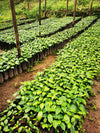

Revitalize Your Plants: Reusing Coffee Grounds as Fertilizer
Jul 3, 2023 (Updated on Aug 19, 2023)

Summary:
We think our African Coffee Beans should never go to waste in the hope of re-useabliy and circlur recycling. So we looked into what our customers can do with used ground coffee and this resulted in this article.
In Sumarry we want you to learn how to reuse coffee grounds to fertilize your houseplants and reduce household waste.
So Coffee grounds contain nutrients and micronutrients that can benefit your plants. Follow these tips to give your coffee grounds a second life:
1. Opt for used coffee grounds instead of fresh ones, as fresh grounds can be high in acidity and caffeine, which may negatively affect houseplants.
2. Add used coffee grounds to your compost pile along with other natural waste. Mix a small amount of compost with potting soil and distribute it among your plants.
3. Alternatively, create a liquid fertilizer by diluting used coffee grounds in water. Use about a teaspoon of coffee grounds per gallon of water. Let the mixture steep, strain it, and use the liquid to water your plants.
4. If you sprinkle coffee grounds on top of the soil, do so sparingly to avoid creating a barrier to water penetration and air circulation.
5. Remember that coffee grounds alone may not provide all the nutrients your plants need. Consider using a premade houseplant fertilizer or repotting with fresh potting mix for additional nutrients.
Reusing coffee grounds is a simple and cost-effective way to nourish your houseplants while reducing waste.
**Full Article:**
How to Reuse Coffee Grounds to Fertilize Houseplants
...
Did you know you can recycle your used coffee grounds into fertilizer for your plants? Learn more about reusing this common kitchen waste item in your plant care routine.
Back To Blog
If you’re a coffee drinker or share your space with one, you’re most likely familiar with coffee grounds. But did you know you can reuse this common kitchen waste item? Coffee grounds can contain nutrients and micronutrients like nitrogen, potassium, magnesium, calcium, and other trace minerals. Recycling your old coffee grounds is an easy way to fertilize plants and help reduce your household waste.
Ready to recycle yours? Follow along for our tips and tricks on how to give your coffee grounds a second life.
1. Opt for used coffee grounds, instead of fresh.
There are two types of grounds to consider for use with your plants: fresh coffee grounds or used coffee grounds. Fresh grounds are ground-up coffee beans that haven’t been used to brew coffee yet, while used coffee grounds are what’s left over after your coffee has been made.
When considering using coffee grounds to fertilize your houseplants, we recommend sticking with used coffee grounds. This is because fresh grounds can be high in acidity and caffeine, which can have a negative impact on your houseplants. There are a select few plants that can benefit from fresh grounds—including acidity-loving Hydrangeas, Rhododendrons, Azaleas, Lily of the Valley, blueberries, carrots, and radishes—but generally, most common houseplants will prefer low to no acidity.
.
2. Add used coffee grounds to your compost.
There is a lot of conflicting information online on how to repurpose used coffee grounds into fertilizer. The most accepted method, which we also recommend as the best for your plants, is adding the used grounds to your compost.
To get started, add the used coffee grounds to your compost pile, which usually consists of vegetable peels, fruit skins, and other types of natural waste. When your compost is ready, mix a small amount of it with potting soil and distribute among your plants.
Depending on what was in your compost mix, be cautious of how much compost you use. Excessive amounts of compost or coffee grounds can lead to foliage burn and nutrient toxicity. Just like with store-bought fertilizer, a little goes a long way. Compost is filled with rich, organic matter and naturally retains water, so not only will you want to be mindful of how much you mix in your potting soil, but you will also want to be mindful of how often you water your plant potted in it. If you are keen on adding compost to your potting soil for the nutrients, consider also adding coarse sand or perlite to the potting mix to help decrease the risk of overwatering.
.





